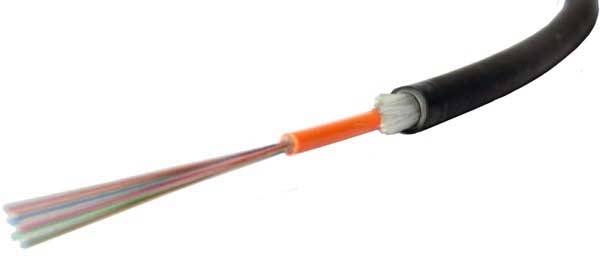Fiber optic cables are used to transmit optical signals in modes. The mode is a path that the light beam travels along with the fiber. According to the number of modes, fiber optic cables can be divided into single-mode and multi-mode fiber cables.
1. Single-Mode Fiber Optic Cable
Single-mode fiber is also called OS or Optical single-mode fiber, it contains a very thin core about 5-10 microns (millionths of a meter) in diameter. All signals go straight from the middle without bouncing off the edges (yellow line in the diagram).
Single model fiber has the simplest structure, it can be divided into OS1 and OS2, their main difference is cable construction rather than optical specifications. The OS1 type cable uses a tight buffer structure, while the OS2 is a loose tube or blown cable structure.
- OS1 Single Mode Tight Buffered Cable
Each OS1 fiber has its own double layer of protective coating, one layer is plastic and the other layer is waterproof acrylate. This tight-buffered cable has a smaller, lighter-weight cable, which is more flexible and crush resistant than Loose Tube. As there is no gel to clean, and no connector terminals for fan-out components, the installation is easier.
Application: OS1 single-mode fiber can support speeds up to 10G and distances up to about 10km (6 miles). It is mainly used indoors, such as moderate distance telco local loops, LANs, and point-to-point links in cities, buildings, factories, office parks, or campuses.
- OS2 Single Mode Loose Tube Cable
Apart from the outer coating, all fibers of OS2 are essentially bare, and each fiber has a colored coating for identification. In addition, the fiber “floats” in a strong, wear-resistant, oversized tube, which is usually filled with optical gel to protect the fiber from moisture. The connector terminal requires a fan-out assembly.
Application: OS2 single-mode loose tube cable can support speeds up to 100G and distances up to 200km (124 miles). It is widely used in outdoor applications, such as high fiber count, long-distance telco backbone and backhaul lines, and direct bury applications along streets and railroads.
Single Mode Fiber Summary
Single-mode fiber is the standard choice for high data rates or long-distance transmission. Compared with multi-mode fiber optic cable, single-mode fiber can transmit signals at a higher speed with less signal attenuation and external interference.
2. Multi-mode Fiber Optic Cable
In a multimode fiber cable, the size of each fiber is about 10 times that of a single-mode fiber. It means that the light beam can pass through the core in a variety of different modes (yellow, orange, blue, and cyan lines).
As the multimode fiber optic cable disperses the light propagating along with the core into multiple paths, this allows higher bandwidth in short and medium distances. However, in a long cable operation, multiple paths of light will cause distortion at the receiving end, resulting in unclear and incomplete data transmission.
Therefore, Multimode is usually only used for short-distance applications such as data centers.
Here are the types of multimode fiber cable and their specifications:
OM1
- Jacket Color – Orange
- Core Size – 62.5um
- Data Rate – 1Gb @ 850nm wavelength
- Distance – Up to 300 meters
- Application – Short-haul networks, Local Area Networks(LANs) & private networks
OM2
- Jacket Color – Orange
- Core Size – 50um
- Data Rate – 1Gb @ 850nm wavelength
- Distance – Up to 600 meters
- Application – Short-haul networks, Local Area Networks(LANs) & private networks
- Generally used for shorter distances. Has twice the distance capacity has OM1
OM3 – laser-optimized Multimode
- Jacket Color – Aqua
- Core Size – 50um
- Data Rate – 10Gb @ 850nm wavelength
- Distance – Up to 300 meters
- Uses fewer modes of light, enabling increased speeds
- Able to run 40GB or 100GB up to 100 meters utilizing an MPO connector
- Application – Larger Private Networks
OM4 – Laser Optimized Multimode
- Jacket Color – Aqua
- Core Size – 50um
- Data Rate – 10G @ 850nm wavelength
- Distance – Up to 550 meters
- Able to run 100GB up to 150 meters utilizing an MPO connector
- Application – High-Speed Networks, Data Centers, Financial Centers, and Corporate Campuses
OM5 – The latest and greatest in Multimode Fiber
- Jacket Color – Lime Green
- Fully compatible and can mate with OM3 and OM4 cabling
- Utilizes a wider range of wavelengths between 850nm and 953nm
- Designed to support Short Wavelength Division Multiplexing (SWDM)
- Can Transmit 40 Gb/s and 100 Gb/s
- Application – High-speed Networks and Data Centers that require greater link distances and higher speeds.
As OM1 and OM2 fiber cables can’t reach higher speeds, OM3 and OM4 have become the mainstream for multimode fiber supporting 25G, 40G, and 100G Ethernet. In the past 30 years, multimode fiber cable has made great progress so far OM5 has been developed in data centers to expand the advantages of multimode fiber.




